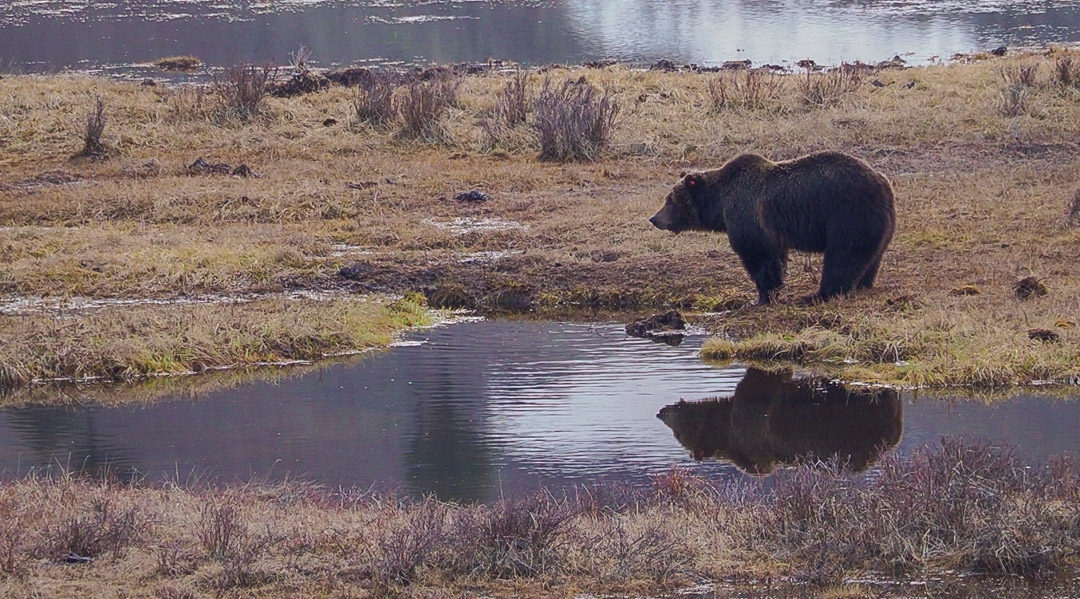He was dubbed “Yoga Bear”. The name was given to this playful Yellowstone grizzly after seeing him play with his irresistible, people-like feet, stretching, twisting and rolling himself into all manner of un-ursine-like positions. This adult grizzly bear appeared lost in his own autumn reverie, preoccupied with a whimsical journey of self-discovery. At times he would roll over and grab his foot as if to say, “Hey! Whoa, check this thing out!… oh, wait… IT’S ATTACHED!” The bear was not in this spot by chance and his antics were not simply meant to pass the time before hibernation—he was engaged in a something much more important—guarding treasure. Beside him, a pile of grass, snow and other

“Yoga Bear” Bronze, 12″L x 9.5″ W x 12.5″H; edition of 22.
flotsam belied the true motives of his post; underneath that debris was the carcass of an elk killed by wolves, which he so happily commandeered. The saying, “move your feet, lose your seat,” applies not only in classroom games, but in the wild too, but here the game is one of life and death where possession is not a fractional part of the law, it is the law. For all of his light-hearted ways, the only difference between that fun-loving, teddy bear and a vicious nightmare is the number of yards you choose to place between you and his prize.
“Yoga Bear” lingered long enough into the fall that he was soon dubbed “the Solstice Bear,” and in a few more days, he was christened “the Christmas Bear”. Though females, especially those with small cubs, go into the den as early as mid– to late–October, it is not unusual for male grizzlies to stay out into early winter, not entering the den until sometime between Christmas and New Year’s. Those same male bears are also the first ones to exit their dens in spring, making tracks in the Yellowstone snow as early as the waning days of February.
Seeing a non-human being exhibit traits that we usually associate with our own kind, particularly humor, helps bridge that divide that we presume exists between us from the rest of the animal world. Humor is universal, not to mention it being inescapably joyful to observe in wild creatures. Granted, many animals that we find funny are not meaning to be comic relief at all, rather, they carry labels and interpretations that we humans assign them. But when it comes to bears and a few other species, I can’t help but feel that they do have a genuine sense of humor. To watch young and old play with one another, play tricks, hatch plans and foil those of others, you can’t help but think there’s more going on behind those eyes. A great example of this was observed by some friends one spring several years ago

Shoulder season grizzly bear tracks in snow (NPS photo)
high on Specimen Ridge in the Lamar Valley of Yellowstone. There was a pair of grizzly bear cubs doing their best to climb directly up the overhanging face of a snow cornice. Both cubs battled against the elements in earnest only to slide back down in defeat. This went on for some time until one of the cubs got the bright idea to go around the end of the cornice and climb up the easy way. As the cub on top inched out to the lip of the cornice, its sibling was almost to the point of success via the harder path. At that moment, the cub on top swatted the other on the head like an over-sized game of wack-a-mole—sending the lower one rolling back down the snowy slope! In another instance involving an adult grizzly bear, these same friends had the chance to witness what appeared to be a male grizzly walking down the road just west of the Yellowstone Institute in Lamar. It was spring and the snow poles, those brightly colored, fiberglass sticks that line each side of the pavement to mark the edge for drivers and snowplows, had yet to be removed. As that bear approached the first snow pole, it reached up with its front paw and smacked it so that it swung back and forth like a windshield wiper gone mad. The bear continued walking along the road for the better part of half-a-mile—swatting every single snow pole that it passed.
When we see an animal play, we cannot help but smile. In the presence of romping children, frisky bison calves, head-butting bighorn lambs or wrestling bear cubs, it has a way of making us feel like kids again. Research shows us that when other people smile at us, whether we physically return the kindness or not, our brain chemistry is actually doing it for us, albeit, behind the scenes. We need these connections to know that we are not alone in this world; we have kinship in many more places than we realize and in the end it makes us better human beings for recognizing it. In the spirit of the Baba Dioum quote, “In the end we will conserve only what we love; we will love only what we understand; and we will understand only what we are taught,” and to this end, some of our greatest teachers have been grizzly bears.
“Yoga Bear” is cast in bronze in an edition of 30, and measures 12″L x 9″W x 12.5″H. To purchase this piece, contact us. To see more of George’s work, visit his gallery.
Photos ©George Bumann and Jenny Golding

